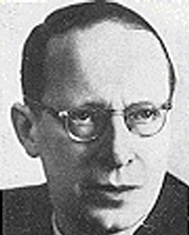|
|
Robert Blum (Composer) |
|
Born: November 27, 1900 - Zürich, Switzerland
Died: December 10, 1994 - Bellikon, canton of Aargau (or Zürich), Switzerland |
|
The Swiss composer, conductor and teacher, Robert (Karl Moritz) Blum, belongs to the most important film-composers. He was a student of Andreae, Baldegger, Jarnach, Laquai, and Vogler at the Zürich Conservatory from 1912 to 1922. He received an education as a conductor and went to Berlin after World War I. There he went to school together with personalities like Wladimir Vogel and Kurt Weill. In 1923 he attended Ferruccio Busoni's master-class in composition at the Prussian Academy of Arts in Berlin.
After finishing his studies in Berlin, Robert Blum returned to Switzerland and conducted various amateur orchsestra and choirs. In 1935 he founded the Madrigalcho Zürich in order to perform the music of the old Englishmen, Dutchmen and Italians as well as contemporary works. In 1943 he became teacher for composition and counterpoint at the Konservatorium Zürich, where he educated for many years (until 1976) several generations of Swiss composers.
Robert Blum's main field of activity was the composition. His works comprise pieces of music from the opera as far as chamber music. Besides his works his strong forte was expressed at its best in the music for movies. Although Robert Blum viewed this genre as a sideline, exactly this music made him well-known. For nearly all big Swiss movies in the 1940's and 1950's he supplied the score - Wachtmeister Studer (1039), Gilberte de Courgenay (1941), Die letzte Chance (1945), Heidi (1952) and Uli der Knecht (1954) are only some examples. |
|
Works |
|
Dramatic:
Amarapura, opera (1924); film music.
Orchestral:
10 symphonies (1924-1980); 4 Partite (1929, 1935, 1953, 1967); Passionskonzert for Organ and Strings (1943); Lamentatio angelorum for Chamber Orchestra (1943); Overture on Swiss Folk Songs (1944); Viola Concerto (1951); Concerto for Orchestra (1955); Oboe Concerto (1960); Christ ist erstanden (1962); Triple Concerto for Violin, Oboe, Trumpet, and Chamber Orchestra (1963); Concertante Symphonie for Wind Quintet and Chamber Orch. (1964).
Chamber:
3 string quartets; Flute Quartet (1963); Sonata for Flute and Violin (1963); Divertimento for 10 Instruments (1966); Le Tombe di Ravenna for 11 Winds (1968); Quartet for Clarinet and String Trio (1970); piano pieces; organ music.
Vocal:
Oratorios; cantatas; Psalms; hymns; songs. |
 |
|
Source: The Swiss Film Website; Baker’s Biographical Dictionary of 20th Century Classical Musicians (1997)
Contributed by Aryeh Oron (April 2006) |
|
Use of Chorale Melodies in his works |
|
Title |
Chorale Melody |
Year |
|
Variationen on Aus tiefer Not, for orchestra |
Aus tiefer Not schrei ich zu dir |
1952 |
|
Christ ist erstanden, for orchestra |
Christ ist erstanden |
1962 |
|
|